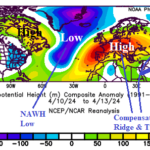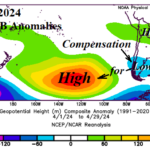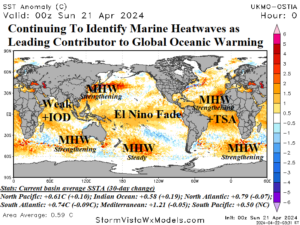
MJO, NAWH, and IOD Contribute to Southern Ural Region/Northern Kazakhstan to Dubai Flooding
04/17/2024, 2:59 pm EDT
Marine Heatwave Drives Rio Grande do Sul Extreme Rains
05/02/2024, 8:46 am EDT
Fig. 1: Daily global SSTA analysis and identification of areas contributing record warm global SSTA.
Discussion: March 2024 brought the 12th consecutive month of record warm global oceans. The daily global SSTA analysis reveals the influence on record warm global oceans by marine heatwaves (MHW). Several MHW’s are steady or strengthening in the southern hemisphere while the second year of a MHW off the Northwest Africa Coast is regaining strength and a new MHW is forming off the coast of East Asia. Extremely warm SSTA are observed in the Mediterranean Sea, Black Sea, and Caspian Sea. In the tropics, a weak positive phase Indian Ocean dipole (+IOD) has regenerated and is expected to strengthen according to Australia Bureau of Meteorology. El Nino continues to fade slowly.
Are these warm ocean regions affecting climate? Yes, and with dramatic character. Through Q1/2024 the most profound influences are stronger than normal subtropical high-pressure ridging associated with warm SSTA either side of South America causing a continental (except East Brazil) dry climate. A strong subtropical ridge across the MHW southwest of Africa has generated a South Africa drought.
More recently, the Northwest Coast of Africa MHW coupled with warmth of the Mediterranean Sea to the Black Sea and Caspian Sea is well-correlated with strong high pressure drying-out Southwest Russia while a compensating downstream trough has caused historical rains in parts of the Middle East. An amplified upper ridge has formed over the new MHW just north of Japan affecting East Asia climate. The combination of re-emerging +IOD and changing ENSO regime continues to dry-out India and Southeast Asia.
A glance at the 1-year SSTA change reveals that the largest contributor to the record warm global oceans are the southern hemisphere MHW’s. There is a tendency for mid-latitude SSTA to peak after summertime has ended while cooling SSTA peaks after wintertime passes. Most global SSTA forecasts valid for AUG/SEP/OCT 2024 widen/strengthen North Pacific/North Atlantic warming and maintain warmth in the Indian Ocean and waters surrounding Australia to the South-central Pacific. The only cooling is with an anticipated La Nina and the South Atlantic. Expect re-intensifying influence of MHW’s on northern hemisphere subtropical ridging for upcoming mid-to-late summer.

Fig. 2: The daily global SSTA 1-year change identifying the profound warm differences in the southern hemisphere.

